The Story Process Origins of a Dissonant Redemption: The Rise of Skywalker Revisited
At the beginning of this year in the weeks following the theatrical release of The Rise of Skywalker, FANgirl Blog published a six-part series of posts analyzing the many storytelling and characterization failures that unfortunately permeated the final film in the Sequel Trilogy. Since then, much more has come to light about the story process behind the movie, including making-of insight from The Art of The Rise of Skywalker and the documentary The Skywalker Legacy in the home video release. This new information provides additional perspective on the origins of the flaws in the film. In particular, it reinforces the dissonance between the portrayal of Kylo Ren in the first ninety minutes of The Rise of Skywalker and his sudden and unearned redemption as Ben Solo for the remainder of the movie – and emphasizes that this dissonance was present throughout the story process in the contrast between the new and different character arc created for Kylo Ren on the one hand, and an apparent unwillingness to conclude his story in any way except by duplicating the fate of Darth Vader on the other. The incoherence of the character’s story in the trilogy’s third film was inherent in the story creators’ failure to choose one path over the other to resolve the irreconcilable conflict.
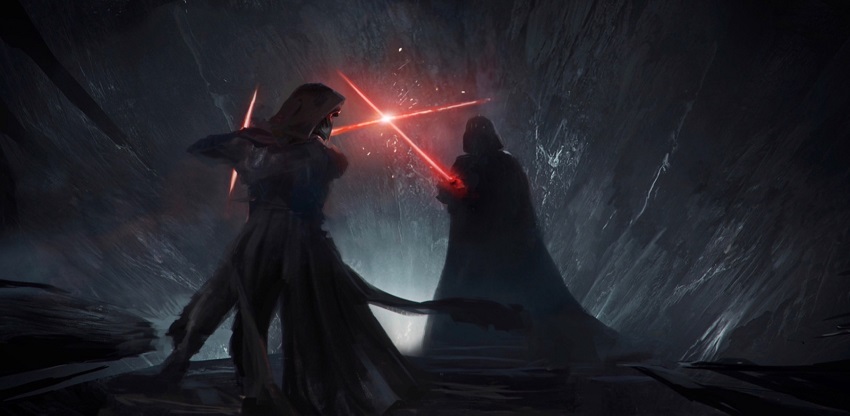
The Conception and Creation of Kylo Ren’s Trilogy Arc
According to The Art of The Last Jedi (p19), the story decision that Han Solo would be killed by his son in Episode VII had been reached by “late summer 2013” while the Visualists in the art department were still hard at work developing the look of The Force Awakens and were looped in on that secret. Casting for director J.J. Abrams began later that year, with Adam Driver signed to play Kylo Ren in early 2014. In The Skywalker Legacy, Driver reiterated the description of his character’s story arc that he also had mentioned shortly before Episode IX’s release:
“At the start of [The Rise of Skywalker] you find Kylo the most assured of the choices that he’s making, going deeper and deeper into the dark side. The thing that J.J. said to me when we first met was that I imagine a journey of a character where it’s almost the opposite of Vader. Someone who almost starts the most vulnerable, and kind of gradually becomes closer to his convictions, more assured about his choices, had metaphorically and physically killed his father.”
Driver took the role understanding that Kylo Ren would be most conflicted and torn in Episode VII, and grow more evil and more assured in the dark side as Episodes VIII and IX unfolded.
As recounted by The Art of The Rise of Skywalker (p34):
“[O]n May 21, 2014, a week after the start of principal photography on The Force Awakens, Lucasfilm’s informal Intellectual Property Development Group (IPDG), formed by Lucasfilm development executive Kiri Hart, met to discuss how they envisioned the then-untitled Star Wars Episode VIII and IX, now that the plot of Episode VII was finalized.”
During the meeting, Dave Filoni explained the implications for the path of the Sequel Trilogy (p35): “What happens to Kylo and what he does to his father is, structurally, not a redeemable act. There’s no coming back from that, the way he does it currently.”
By that point, Filoni had worked closely with George Lucas developing and producing six seasons of The Clone Wars, giving him direct insight into Lucas’ thinking about Anakin Skywalker’s fall to the dark side and the story decisions made in Attack of the Clones, The Clone Wars, and Revenge of the Sith. Although Lucas in Episode III did not shy away from making clear that Anakin was responsible for numerous dark deeds – especially personally murdering numerous Jedi, including younglings, as part of Order 66 – Lucas also went out of his way to make clear that Anakin did not kill Padmé. Despite his Force choke of her, she tells Obi-Wan there is still good in him. The medical droid attributes her death to “reasons we cannot explain” and losing the will to live. This echoes Return of the Jedi, in which Luke is confident there is still good in Vader despite his having severed Luke’s hand in the previous film, and insists to Obi-Wan that he cannot kill his own father. Of course, the decision to portray Padmé’s fate in this way was profoundly harmful to her own characterization and character arc in the Prequel Trilogy, but it was crucial to Lucas’ reasoning in fridging her: to preserve Anakin’s redemption in Episode VI, that he could not be the one who killed Padmé in Episode III.
Thus, Filoni’s explanation at the IPDG meeting is consistent with the story intention expressed to Driver by Abrams. Kylo Ren’s decision in The Force Awakens not only to choose the dark side, but also to kill his father as the defining act in doing so, puts Kylo in the Sequel Trilogy on a different path from Vader in the Original Trilogy. In the first movie of his trilogy, Kylo Ren already has crossed a line that Darth Vader never did.
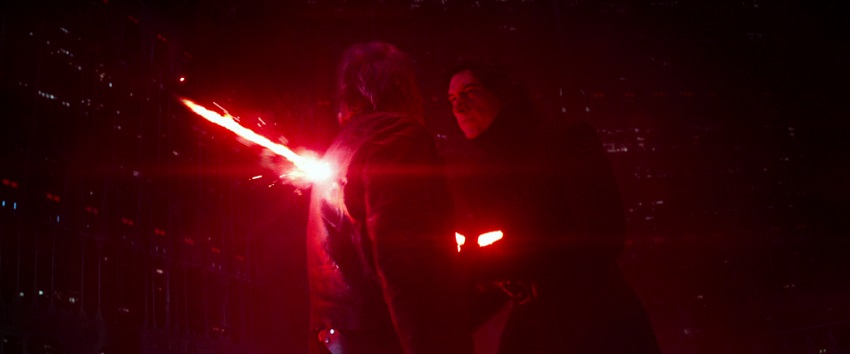
At the same IPDG meeting, however, the participants discussed an alternative angle to the story that nevertheless might be able to provide a redemptive ending. Doug Chiang made a suggestion about Leia’s role (p35): “Maybe she’s the nurturing character that overcomes the final evil.” Filoni continued his assessment of Kylo Ren by following up on that idea (p35): “But I’ve never seen the mother character try to do it. And maybe she could. … The idea that we have Leia, a mother character who needs healing in her own right – that’s something we can get into in a deeper way.” Perhaps the thematic norms of Lucas’ story of a father and a son could play out differently with a mother.
While principal photography on The Force Awakens continued through November 2014, Rian Johnson’s first day at Lucasfilm onEpisode VIII was July 2, 2014, as confirmed by The Art of The Last Jedi (p77). (The hiring was not officially announced until March 2015.) Eighteen months later, Disney CEO Bob Iger read Johnson’s draft for The Last Jedi after the world premiere of The Force Awakens in December 2015. Principal photography for The Last Jedi took place from February to July 2016.
Work on Episode IX also was underway at this time. Colin Trevorrow was announced as director at D23 Expo in August 2015. He filmed The Book of Henry that fall before turning to Star Wars with frequent writing partner Derek Connolly. Their December 2016 draft, titled Duel of the Fates, has subsequently become available on the internet along with several dozen works of concept art for that version of Episode IX.
Given the timing of its completion during the creative process – while The Last Jedi was in editing and post-production and over a year before Episode VIII’s theatrical release – it is worth examining how the Duel of the Fates script portrays Kylo Ren and his character arc in Episode IX. As in The Rise of Skywalker, Kylo Ren is the Supreme Leader of the First Order, seeking to consolidate his political and military domination of the galaxy by crushing the Resistance. He also seeks to increase his own strength in the dark side of the Force, finding a Sith holocron at Vader’s castle that leads him to an ancient dark side figure, from whom he learns a disturbing new power before killing it with that very power. Kylo rightfully views Rey as the greatest threat to him. As in The Rise of Skywalker, their paths culminate in a fight to the death, which in Duel of the Fates takes place at the mystical temple of Mortis. There Rey demands that he admit the truth she has always subconsciously known – that Kylo Ren killed her parents, who had hidden Rey on Jakku to protect her from him – and he does. And he is still fully committed to the dark side. Having been maimed even further than in The Last Jedi by the power of the Sith holocron, Kylo uses the dark side to drain Rey’s life Force and restore himself to a healed and hale body.
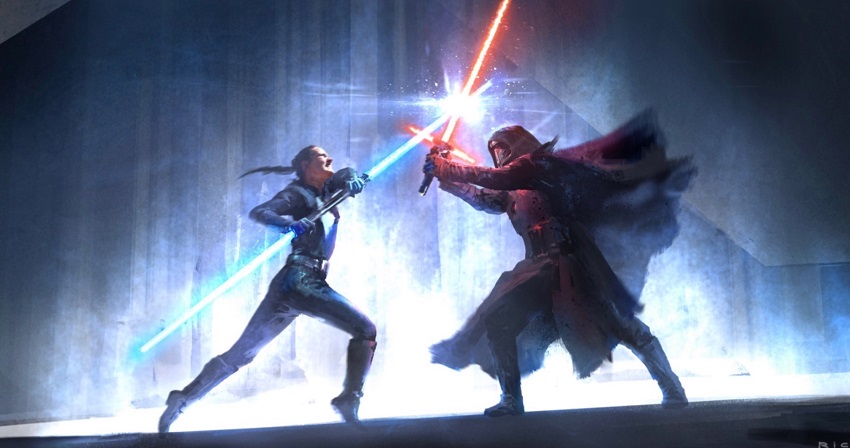
In Duel of the Fates as well, Kylo Ren is moments away from killing Rey when his mother reaches out to him in the Force. (Unlike The Rise of Skywalker, this action is not fatal, and Leia is alive along with the other heroes at the end of the story.) Hearing Leia’s voice touches his soul, and he abruptly abandons the dark side: “Something HAPPENS to Kylo when he hears his mother’s voice,” the screenplay says, and then a few lines later, “Kylo feels the very thing that destroyed Anakin. But doesn’t make him feel weak. He looks at Rey’s outstretched hand … and TAKES IT.” After returning the life Force to Rey, Ben Solo dies. Unlike The Rise of Skywalker, where Leia’s contact occurs at Kef Bir and Ben’s replenishment of Rey and death occurs at Exegol, in Duel of the Fates these events take place consecutively at the film’s climax, on pages 117-119 in a script of 128 pages in length. Thus, in the Duel of the Fates story in December 2016, Kylo Ren is the Big Bad for the entire film, and his sudden redemptive fate is a momentary event transpiring perhaps a minute or two before his death.
Subsequent to Carrie Fisher’s passing on December 27, 2016, Trevorrow and Connolly apparently produced at least one revised screenplay. According to industry reports, creative differences over the direction of the story led to the hiring of Jack Thorne in the summer 2017 to revise or rewrite the movie.
On September 12, 2017, Lucasfilm announced that Abrams would return to direct Episode IX, with Chris Terrio as co-writer. Ten days later, on September 22, Rian Johnson revealed on social media that The Last Jedi had wrapped production, a few days shy of three months before its world premiere in December. According to The Art of The Rise of Skywalker (p91), “Abrams pitched his current Trixie story, complemented by the latest concept-art moviescape, to” Iger and Kathleen Kennedy at that premiere – after only three months of work. The book’s author, Lucasfilm creative art manager Phil Szostak, later revealed on Twitter that concept art for Palpatine’s return in the film was dated as early as October 11, 2017, “mere days after the art department started on the film.” Principal photography for The Rise of Skywalker lasted from August 2018 to February 2019, and the film released as scheduled in December.

Reaffirming the Villain’s Journey of Kylo Ren
The above chronology, especially the consistent vector of Kylo Ren’s narrative from 2013 to 2016, reaffirms that the principal identity of his intended character arc in the Sequel Trilogy was a villainous one – the descent into darkness described to Driver by Abrams. In a February 2018 post, I analyzed Kylo Ren’s arc in The Last Jedi as a Villain’s Journey juxtaposed against the Hero’s Journey paths of Rey and Finn in the same film. Presenting a similar analysis of his character arc across The Force Awakens and The Last Jedi together, Issue #179 of Star Wars Insider magazine (the March-April 2018 edition) contained Tricia Barr’s article “Footprints on the Crait Salt Flats: The Dark Path of Kylo Ren,” which had been solicited as such by the magazine and reviewed by an editor at Lucasfilm prior to publication. But we were not the only ones drawing such a conclusion about Kylo Ren’s path.
Frank Lehman, a musicologist on the faculty of Tufts University renowned for his detailed analysis of the numerous motifs in the Star Wars scores by John Williams (available as a 57-page PDF at his website), concluded in his December 2017 analysis of The Last Jedi that the music associated with Kylo Ren grows increasingly darker and more ominous over the course of the film. Lehman further concluded that the music accordingly suggested that Ren will reach his darkest point in the trilogy in the then-untitled Episode IX. Lehman’s interpretation was validated by the featurette “The Maestro’s Finale” on The Rise of Skywalker home video release. At the 5:25 mark in the video, Williams recounts that Abrams asked the composer if it would be possible to “make the trip from Ren to Ben on the same theme,” which Williams accomplished by reorchestrating Kylo Ren’s theme for the Exegol sequences. Abrams is then shown at a scoring session explaining his reasoning to Williams: “The idea that he’s trying his hardest now to be the best that he can be, as opposed to he’s trying his hardest to be as bad as he can be, which is what he’s been doing.”
The vector of Kylo Ren’s path in The Force Awakens and The Last Jedi, leading toward an even darker and more evil villain in Episode IX, was further reinforced by a variety sources prior to the release of The Rise of Skywalker. In the summer and fall of 2019, the Star Wars: Galaxy’s Edge theme park expansions opened at Disneyland in California and Disney World in Florida. The narrative story elements of Galaxy’s Edge occur after The Last Jedi and before The Rise of Skywalker, and in the parks Kylo Ren is unambiguously portrayed as a villain when he emerges and interacts with guests. Likewise, the First Order troopers and officers are on the hunt for Resistance operatives, taking a particular interest in Rey. The trailers for The Rise of Skywalker released in April and October of 2019 also positioned Kylo Ren as Rey’s nemesis, accurately foreshadowing that they clash three times in the film (at Pasaana, Kijimi, and Kef Bir). Similarly, by showing Kylo Ren’s reforged helmet, the trailers and other promotional material suggested that his fractured resolve early in The Last Jedi has now been rebuilt stronger than ever for his reappearance in The Rise of Skywalker.
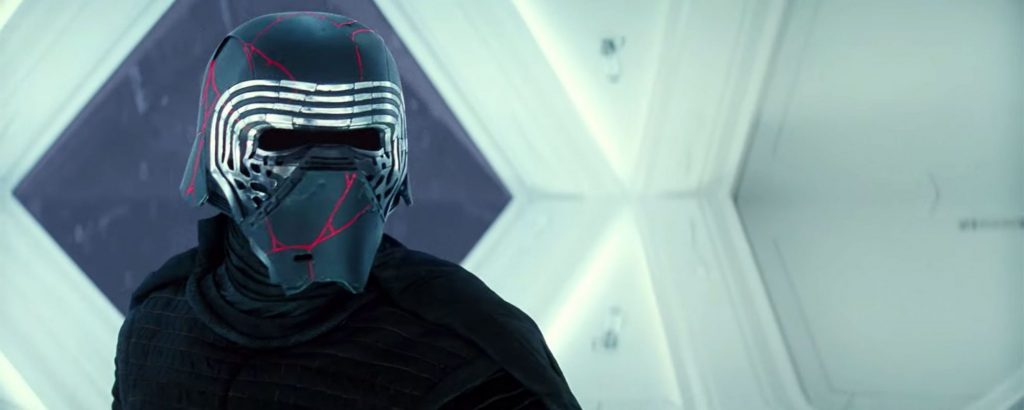
The publishing program “Journey to The Rise of Skywalker” followed the same approach. In Age of Resistance – Snoke, Kylo confronts his own worst fears in the Dagobah tree cave while training with Snoke before the events of The Force Awakens, revealing that while he would not hesitate to try to kill Luke, he could not (yet) bring himself to strike down either of his parents. In Age of Resistance – General Hux, after Hux and Ren are marooned on an isolated world following a failed assassination attempt, Hux successfully dupes a survivor of Alderaan into trusting them because “Ben” is Leia Organa’s son – underestimating his capacity to choose evil because of his family ties, the same mistake both Luke and Rey are shown to make in The Last Jedi. And in Age of Resistance – Kylo Ren, the entire comic issue centers on Kylo’s ambition to exceed Darth Vader during a military operation on a planet in Wild Space, culminating in Kylo’s successful killing of the same Zillo Beast that Vader had failed to slay decades earlier, impressing an Imperial veteran who served alongside both leaders on their respective missions. In the novels Resistance Reborn and Spark of the Resistance, Kylo Ren is only mentioned in passing as the increasingly ruthless Supreme Leader of the First Order. Finally, he appears on two pages of the Allegiance comic, once to command Hux to pursue a lead about Finn’s whereabouts so that the First Order can “wipe every one of them out of existence” and once to strike down the leader of the planet Fondor for providing aid to the Resistance, declaring “We have learned from the mistakes of the Empire – they were too lenient.”
Upon the release of The Rise of Skywalker, the directional vector of Kylo Ren’s three-movie villainous character arc was reaffirmed. In TFA he orders the massacre of an innocent village on Jakku; in TLJ he orders the massacre of the entire Resistance within the Crait base; in TROS he personally massacres the Vader cultists on Mustafar. In TFA he captures Poe Dameron alive to extract information helpful in his hunt for the map to Luke; in TLJ he kills members of the Resistance from afar by firing torpedoes into the Raddus hangar; in TROS he personally beheads the Resistance collaborator Boolio. In TFA he watches as Snoke fires Starkiller Base at the Hosnian system; in TLJ he refuses Rey’s plea to stand down the First Order fleet from destroying the unarmed Resistance transports; in TROS, he commands his high council to “prepare to crush any worlds that defy us” and Kijimi is later obliterated. In TFA he resents Snoke and squabbles with Hux; in TLJ he kills Snoke and Force-slams Hux; in TROS he commands the First Order and schemes to destroy the returned Palpatine. In TFA he is intrigued by Rey, surprised by her strength in the Force and her willingness to oppose him; in TLJ he tries to turn Rey to the dark side, undermining her trust in Luke and exploiting her optimism based on his family’s past; in TROS he stalks Rey across the galaxy, pursuing her to three different planets and repeatedly slinging malicious words despite her pleas to stop. In TFA he rejects Han’s assurance that it’s not too late for “Ben” to come home; in TLJ he rejects Rey’s entreaty for “Ben” to rejoin the light side; in TROS he declares that Rey cannot return to Leia either due to the darkness inside her. In TFA he kills Han; in TLJ he tries to kill Luke twice (in the flashback and at Crait), and though initially hesitates to kill Leia at the Raddus he later orders her death in the attack at Crait (“No quarter. No prisoners.”); in TROS he tries to kill Rey – and would have succeeded if Leia had not telepathically reached out to him at the last second.
Until the abrupt change of heart at Kef Bir, the character arc for Kylo Ren follows the path described by Abrams to Driver early in the story process. Kylo begins the Sequel Trilogy conflicted and not fully sure of himself, but grows into his convictions and confidence over the three films so that by the middle of the third film he has reached the apex of his villainous journey. By then he has nearly finished achieving his goal of finishing what Vader started. Asked about whether Kylo Ren might have a story of redemption in the trilogy’s finale, on the eve of the release of The Rise of Skywalker Adam Driver explained that Kylo Ren would not view his actions in the previous films as errors, but as triumphant accomplishment of his stated goals and repudiation of his prior weaknesses and failures: “He’s already been redeemed in his story.”
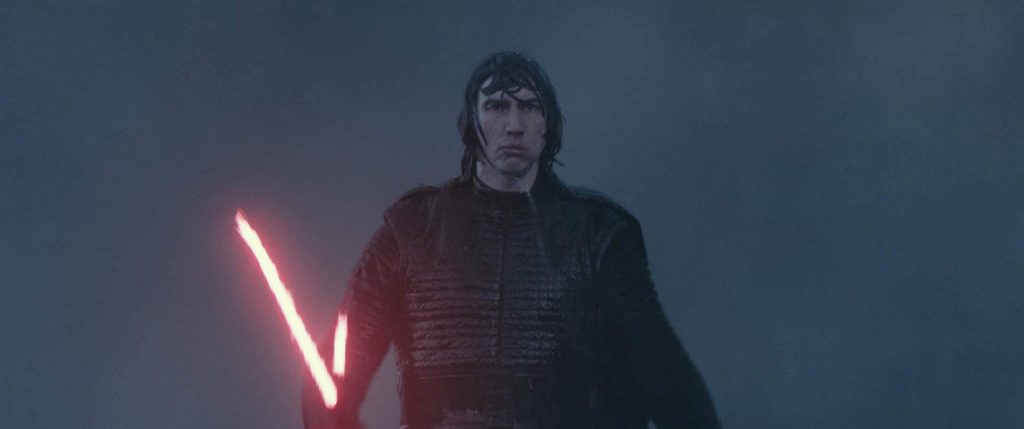
The Dissonant Redemption in The Rise of Skywalker
While the three-movie character arc followed the villainous path for Kylo Ren envisioned by Abrams and Driver, the other aspect of the initial conception never dropped away. Despite committing to pushing him ever deeper into the dark side, the story’s creators apparently remained unwilling to deliver an ending consistent with that tale: the villain slain by a Jedi hero, giving Kylo Ren the same fate as Maul (in The Phantom Menace and Star War Rebels), Dooku and Grievous (in Revenge of the Sith), and Sidious (in Return of the Jedi and The Rise of Skywalker). Unfortunately, the Sequel Trilogy failed to invest in truly telling the story of a mother’s unconditional love for her son as a possible route to redemption – and consequently Ben Solo’s abrupt abandonment of the dark side is dissonant and unearned.
As the creators have mentioned on numerous occasions, the Sequel Trilogy was devised to highlight a different legacy character in each film: Han in Episode VII, Luke in Episode VIII, and Leia in Episode IX. But even this simple notion, reasonable and innocuous enough on its face as it may be, inadvertently created a context in which it became easy for the storytellers to lose sight of the importance of building the groundwork, within the story, for the character moment when Leia’s love redeems her son in the third film.
In The Force Awakens, Leia and Han share a couple of brief conversations about their son, mostly providing exposition on the backstory of his fall to the dark side. Echoing her brother in Episode VI and her mother in Episode III, Leia insists there is still good in him – but each of those is the concluding film in a trilogy, bringing storylines to a close, whereas Episode VII is the starting film a trilogy, when character arcs are only beginning. Before Han leaves for Starkiller Base, Leia asks him to bring their son home. But Leia is wrong about her son. Kylo Ren kills his father and deepens his commitment to the dark side.
In The Last Jedi, Leia senses her son’s hesitation to fire torpedoes at her flagship early in the film. As the First Order batters open the gigantic door to the Crait base, however, his resolve has hardened and Leia quietly admits, “I know my son is gone.” Once the survivors have made their escape aboard the Falcon after being rescued by Rey, Leia assures her that “we have everything we need” to rebuild the Resistance and the Jedi, validating for her that despite Rey’s notion earlier in the film, they do not need Ben’s return to prevail. A hint of a different possibility might be read into two lines from Luke to Leia, but their respective meanings are at most ambiguous. Luke’s recognition that “I can’t save him” might carry the implication that Leia can – but it equally could be interpreted to confirm Leia’s belief that her son is lost to the dark side. Likewise, Luke’s gentle reminder that “no one’s ever really gone” could mean that it is still not too late for Ben to return – but when accompanied by Luke handing her the dice that symbolize her dead husband minutes before Luke’s own act of self-sacrifice in a personal showdown with Kylo Ren, it equally could be interpreted as referring to how the two men who are literally dead will always be with her in her heart and her memories, just like her son who is (for now) metaphorically dead. Regardless, almost the entirety of Rian Johnson’s legacy storyline centers on the conflict between Luke and his nephew. Leia spends most of The Last Jedi in a medical coma, and when she is active her role in the plot involves the character development of Poe Dameron as a leader in the Resistance, not the present or future fate of her son.
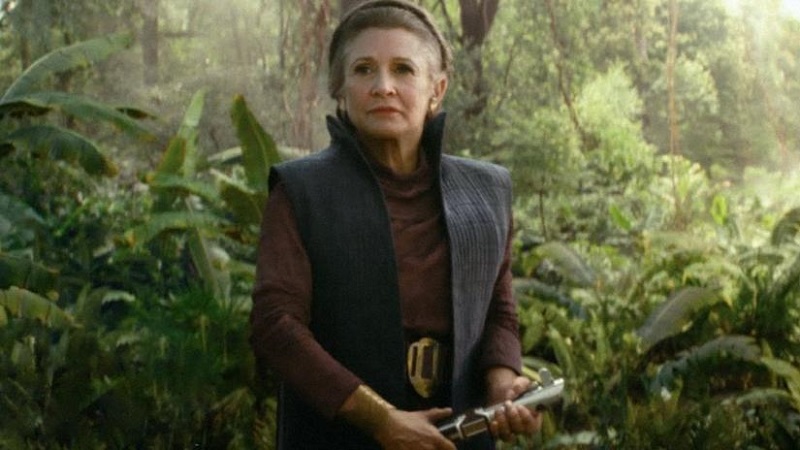
With this setup and the villainous character arc for Kylo Ren, it is difficult to see how Episode IX could have delivered a meaningful and non-dissonant redemption for Kylo Ren through Leia. In Colin Trevorrow’s Duel of the Fates, Leia Organa does have the substantial role contemplated for her legacy film, including numerous important scenes and over five dozen lines of dialogue. But nearly all of them relate to her role as the leader of the Resistance and as a mentor to Rey, Poe, and Finn. Prior to the climax, she senses Kylo’s pain through the Force when he is maimed by Sith holocron. She discusses him with Rey and Luke, but separately and only briefly each time. When she telepathically contacts her son to stop him from killing Rey, she speaks only a handful of words across several lines of dialogue before Ben chooses the light. As noted above, Duel of the Fates leans fully into the villainous path for Kylo Ren for nearly the entire script, and only drops in his redemption very quickly at the very end.
The problem was exacerbated when Abrams and Terrio decided to limit Leia’s involvement in The Rise of Skywalker to previously filmed snippets of dialogue and a few silent visual appearances, hopelessly constraining the story’s ability to develop and portray her feelings and motivations. In the end, Ben’s redemption occurs through a conversation with his own memories of his father, talking in part about his mother rather than with her. Accordingly, it is not surprising that several key members of The Rise of Skywalker team do not describe Ben’s redemption in connection with his mother. The Art of The Rise of Skywalker quotes Terrio as remarking (p60): “Yet there is this inherent optimism in Star Wars that the light in you is never truly gone. That you can still redeem yourself right up until the last minute.” Similarly, Abrams explains (p60): “Maybe it’s the optimist in me, but I would like to think that anyone, even someone who does the most horrendous things, is redeemable.” On The Skywalker Legacy documentary, Driver also does not frame the redemption in terms of Leia, but rather the act of healing bestowed by Rey and Ben’s motivation to honor it:
“Things had come almost full circle with him. For the first time, someone had shown him maybe what he perceived as a huge act of generosity in spite of what he had done. Someone reached out, when no one else had for a long time. Repeating the same exact scene from The Force Awakens, line by line, I thought was a really beautiful way of showing [the full circle aspect] … Before, there’s someone who has the absence of hope. And the thing that we started with for “who is Ben?” then, is someone who has hope. There’s no more ambiguity about what it is that he has to do, there’s no more see-saw that’s happening. For the first time someone who’s never had the answer now finally knows his purpose or destiny. He has to let her know that they’re together, but I don’t know that he entirely is sure what’s going to happen from there, nor do I think he cares. I think it’s so long as he’s with her, he’s on the right path.”
This explanation by Driver, of course, also connects Rey’s act on Kef Bir full circle to the ending at Exegol, where Ben gives up his own life Force to restore Rey’s in a reciprocal act of compassion and generosity.
Finally, it is important to contrast the sudden and dissonant redemption of Kylo Ren in the third film of the Sequel Trilogy with the manner in which the Original Trilogy develops and earns the path of Vader’s redemption through Luke. A New Hope establishes Luke’s wistful fascination with his lost father and his eagerness to learn more about him, before Luke pledges to Obi-Wan that he wishes to “learn the ways of the Force and become a Jedi like my father.” The Empire Strikes Back upends Luke’s perspective with the revelation that Obi-Wan has deceived him and Darth Vader is his father. Once the mission to rescue Han from Jabba’s Palace succeeds, the rest of Luke’s subplot in Return of the Jedi is dedicated to his commitment to facing Darth Vader again so that he can reach the good within him and bring him back from the dark side. The Sequel Trilogy, on the other hand, lacks an equivalent setup and groundwork across its three films, and especially falls short by comparison in the third.
Ultimately, then, the dissonance of the redemption in The Rise of Skywalker arises from the irreconcilable conflict between the two potential fates for Kylo Ren. If the Sequel Trilogy’s storytellers believed in the necessity of a redemptive ending, then they needed to set up and earn that resolution over its full span, as the Original Trilogy did. If the Sequel Trilogy storytellers wanted to give their antagonist a new character arc in Star Wars, a different trajectory than Darth Vader’s, then they needed to pay off the Villain’s Journey that had been envisioned from the start by reaching a different fate for Kylo Ren than his grandfather’s. Instead, The Rise of Skywalker tried to have it both ways, and in the process failed at both, too.
.
Related Links:
- The Last Jedi and the Hero’s Journey – Part Four: Kylo Ren and the Villain’s Journey (Feb. 2018)
- The Fates of Kylo Ren and Ben Solo: The Failures of The Rise of Skywalker, Part 3 (Jan. 2020)

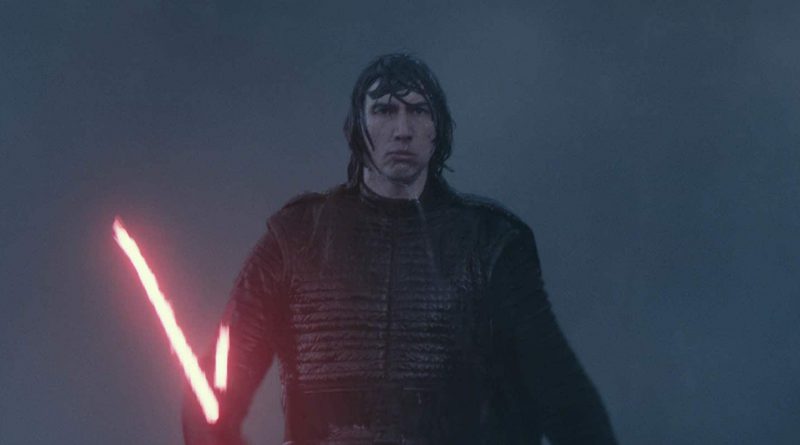







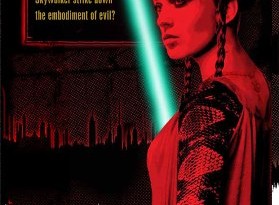

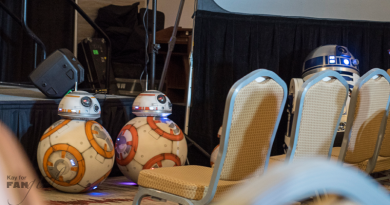
Pingback:New Insights on the Flawed Finale: The Rise of Skywalker Revisited – FANgirl Blog